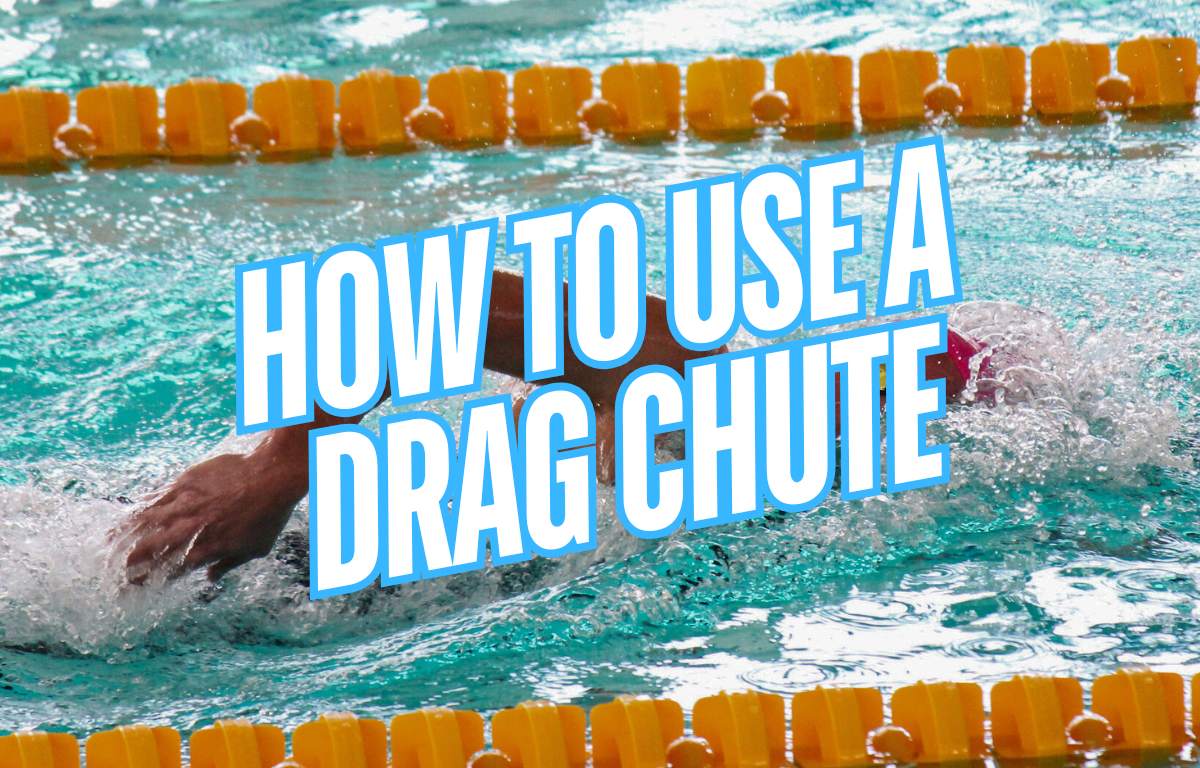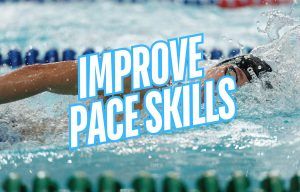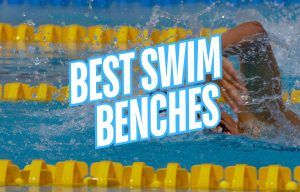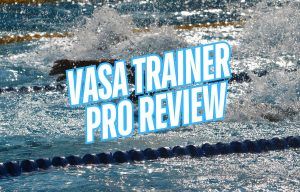Looking for tips on how to use a drag chute for improved swim performances? Read on for some proven tips, sets, and pointers for training with a chute.
The drag chute is one of my favorite types of gear for swimmers looking to get faster in the water. The list of ways that a drag chute can be used to is surprisingly long.
Whether you are trying to improve power and sprinting speed or you are more technique-focused and want to improve technique, using a drag chute can help you out.
In this guide to using a drag chute like a pro, we will look at some simple tips and pointers for making the most from your fancy pants new drag chute.
Let’s dive in!
How to Be a Master with the Drag Chute
While the drag chute looks relatively simple, how you use the chute is what will determine what kind of improvement you see with it.
From set-up to training intensity to technique and sample sets, ways to use a drag chute for more effective swim practices, better technique, and faster swimming include:
- Use light resistance for technique
- Add chute sprints for potentiation
- Kick with the chute for power
- Gradually increase chute size
- Pair with other tools
- Stay clear of lane lines
- Add to your meet warm-up
Next, we will take a peek at more detailed information on how to use a drag chute like a pro.
Use light resistance for technique work
The primary benefit of drag chutes is that they help swimmers develop more power by forcing them to overcome added resistance, eliciting greater muscle fiber recruitment and force development.
But one of my favorite ways to use a drag chute is for technique work. Yup—grab a drag chute that is low to medium resistance and perform 25s or 50s with lots of rest, at sub-maximal speeds (50-70% effort), and hone your technique.
The little bit of added resistance will make you more sensitive to the important parts of your technique, like that early vertical forearm, proper hand placement in the catch, accelerating the hands under the body during the pull/push phase, maintaining a horizontal body position in the water, and other common freestyle stroke errors.
Swimmers are locked in a never-ending battle with the water’s resistance, trying to find ways to slide and sneak through the water more efficiently. For once, we can purposely increase resistance to sensitize our body to use better technique.
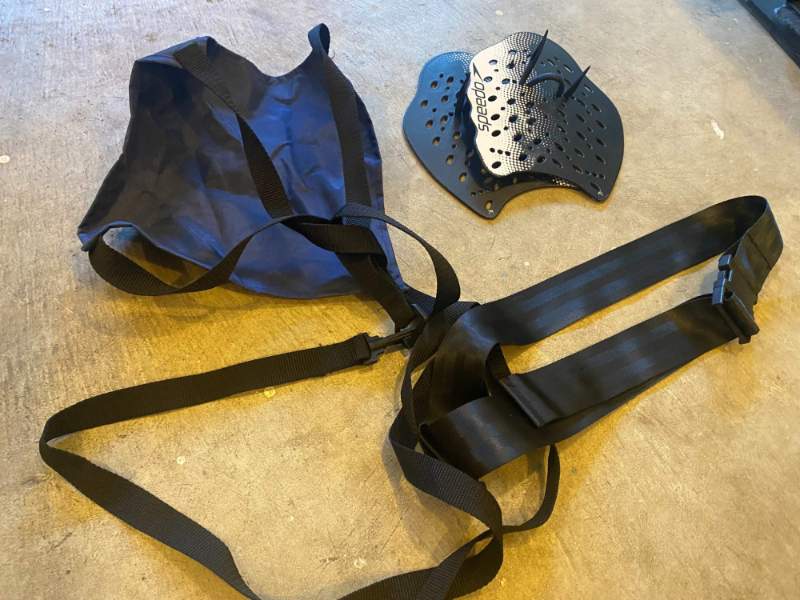
The key, obviously, is choosing a resistance level that doesn’t crater technique or feel like you are swimming with a small child on your back.
Sample set:
16×25 freestyle with drag chute (light resistance)
- ODDS: long dog drill, focus on hitting the catch
- EVENS: swim, 65% effort, working on transferring that elite catch from the drill reps
Add chute sprints for potentiation
Using a drag chute and performing short sprints are a powerful way to activate the nervous system and prime your muscles for a explosive speed later in the workout (or set).
This strategy, known as post-activation potentiation (PAP), is a training concept where you balance high-resistance, high-intensity efforts (15m sprint with a chute), followed by a rest of 2-8 minutes, followed by a sprint effort without resistance.
Several studies with elite competitive swimmers have shown the benefits of post-activation potentiation in improving sprint performances (Kilduff et al., 2011; Hancock et al., 2015).
The added resistance of the drag chute means that more muscle fiber is recruited and “awake,” so that when you take it off and unleash a resistance-free sprint, you feel lighter and faster in the water.
Sample set:
- 4×10 seconds all out with drag chute, maximum resistance – take 90s rest after each repetition
- + 2-8 minutes rest
- 50 swim all-out from the blocks
Swimmers can also use the combination of a drag chute and PAP as part of their pre-set; a small mini-set between the general warm-up and the main set of the swim workout.
Here’s an example of how you would use a drag chute for potentiation right before a big and greasy main set:
| Before | After | |
| Warm-Up | 800m as 200 swim, 200 kick, 200 pull, 200 drill | 800m as 200 swim, 200 kick, 200 pull, 200 drill |
| Pre-Set | – | 8×25 freestyle with light drag chute as 15m all out, 10m easy on 60 seconds 100 swim easy to reset |
| Main Set | 8×50 freestyle best average on 3:00 | 8×50 freestyle best average on 3:00 |
The drag chute set between the warm-up and main set serves as a potentiation and bridge between the general and loose swimming of the warm-up and the highly focused intensity of the main set.
Kick with the chute for power
The kick is a crucial part of fast swimming, whether you are looking to improve your underwater dolphin kick or power up your freestyle kick. And incorporating kick sets with a drag chute is a killer (and proven) way to develop an explosive kick in the water.
A study by Amara et al. (2022) with a group of experienced competitive swimmers put this to the test with a four-month intervention that split swimmers into two groups: a resistance training group and a control group.
The resistance group did kick sets with a chute four times per week along with land-based strength training. The control group did the same kick sets, but without using a drag chute.
After nine weeks, the swimmers in the resistance group showed some legit improvements:
- 30m kick time trial improved by 5.84% (1.22s faster), compared to just 0.22s in the control group.
- 100m freestyle time dropped from 59.56 to 56.93 seconds, while the control group showed only a minimal change (59.49 to 59.21).
Drag chutes aren’t just for building more upper body power, but also for building a more explosive kick and ultimately, faster swimming, too.
Sample set:
5 rounds:
- 4×25 freestyle kick fast with drag chute – 30s rest after each rep
- 100 freestyle kick build (without the chute)
Gradually increase chute size
Drag chutes come in a variety of chute sizes, with smaller, lighter chutes having a diameter of 8″ and the largest ones on the market being 12” to 16” in diameter. Starting with a smaller chute is important to maintain body position and stroke mechanics while getting used to swimming with what can feel like a small child riding your ankles.
Going too big, too soon with a drag chute can result in:
- Stroke breakdown – Stroke tempo craters with excessive drag chute resistance, creating adaptations that aren’t relevant to what we are trying to accomplish in the water.
- Overcompensation – Swimmers find all manner of ways to compensate for swimming against too much resistance, including excess body roll and dropped elbows.
- Excessive fatigue and shoulder strain – And of course, heavy resistance in the water is no different than heavy load on land; we open ourselves up to increased risk of injury by using inappropriate load.
By progressively increasing chute size (and volume and intensity) over time, swimmers can build a foundation of strength and stability from which they can build the power and speed to conquer their personal best times on race day.
Pair with other swim tools
What’s better than using a drag chute? Using it with some of the other gear that is loitering around in your mesh bag.
The key, per usual, is to choose swim gear that complements the OG purpose of the drag chute without overloading your body, compromising technique, or creating competing adaptations.
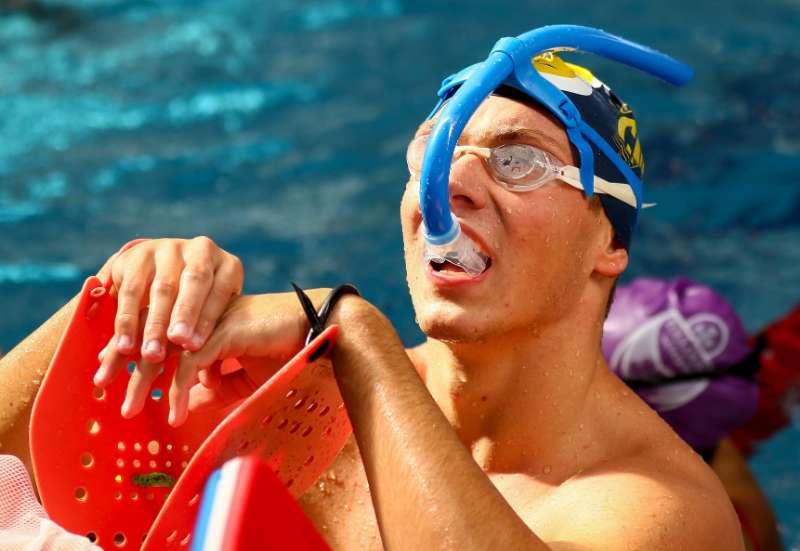
Here are some ideas:
- Drag chute and fins – Swim fins are the #1 type of training equipment for most swimmers. Pairing them with a chute can help develop more power in the legs, particularly in the dolphin kick.
- Drag chute and swim snorkel – The snorkel and drag chute combination is perfect for more technique-oriented swimming. Hit the long course pool, grab your snorkel and a light-resistance chute, and focus on swimming with perfectly balanced and symmetrical strokes all the way down the pool.
- Drag chute and paddles – Pairing swim paddles and a chute creates some serious upper body resistance. Use with caution—this combo places a lot of added stress and torque on the elbow joints—and make sure you have a solid foundation of stroke technique before leveling up to paddles and chutes.
Like always, if technique begins to suffer, and if stroke kinematics begin to look like a shadow of how you usually swim, remove one element.
Pairing a drag chute with other types of swim training equipment can help keep training fresh, effective, and targeted.
Steer clear of lane lines
When using a drag chute, positioning in your lane becomes very important. Since the chute trails and dangles behind your feet, it can get tangled in lane lines, especially those fancy, competition grade lane ropes that are made with high-density polyethylene and steel cables.
Snagging the drag chute in a segment of these lane ropes typically means the chute gets ripped and torn.
Swim just offset from the lane rope, or if possible, in the middle of the lane to keep the chute from drifting into the lane line.
Add to your meet warm-up
Swim meet warm-ups are a chlorinated gong-show from our earliest days in summer club to the final stages of an Olympic career.
The pool is busy, the atmosphere is hectic, and there is frequently a large gap of time between when the general warm-up concludes and the nerve-wracking moment we step up on the block to race.
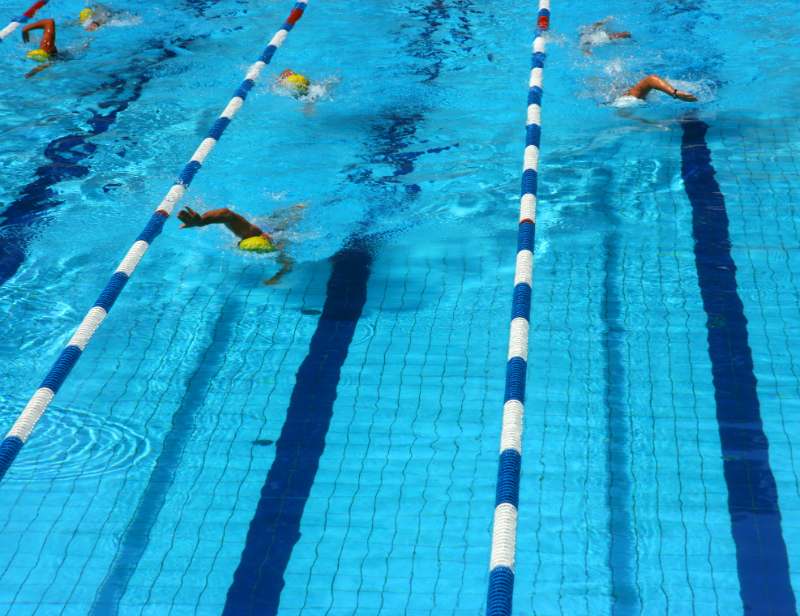
While official meet guidelines tend to disallow various types of training equipment for safety reasons, if you can find yourself a quiet corner of the dive tank or if there is an “equipment lane” at the meet, packing along your drag chute can help ensure that you are ready to rock and roll when it’s race time.
Several short build or explosive reps 10-20 minutes before your race along with some general core warming will help maximize performance when you launch yourself off the blocks.
What is the best chute for swimmers?
The best drag chute for competitive swimmers is the FINIS Swim Parachute.
FINIS, the most innovative swim brand on the pool deck when it comes to swim training equipment, offers their chute in two sizes (8″ or 12”) and uses a 6-foot tether that keeps the chute out of your feet when swimming and kicking.
They’re also wildly durable; I’ve owned both sizes since 2018 and they’ve shown zero signs of deteriorating after years of use.
Pick up both sizes and you can use the smaller chute for technique work and kick sets and deploy the big chute for the power and strength development main sets.
The Bottom Line
Drag chutes are (yet) another tool in the swimmer’s toolbox for faster swimming. And when used with purpose, it can address a broad range of performance factors in the water.
Whether you want to use a drag chute to improve technique, sharpening that catch and hand entry, master better body position, or improve kicking and swimming top-end speeds, adding a drag chute to your swim workouts is a no-brainer.
Use the above tips for mastering the drag chute the next time you hit the water and “chute” for faster swimming and new personal best times!
More Drag Chute Guides
7 Benefits of Training with a Drag Chute. Looking for some proven ways that drag chutes will help you swim faster? Here’s a full list of reasons why swimmers should train with a drag chute.
3 Swim Workouts with Drag Chutes. Looking for swim workouts with a drag chute to bolster swim speed and hone technique? Here ya go.

